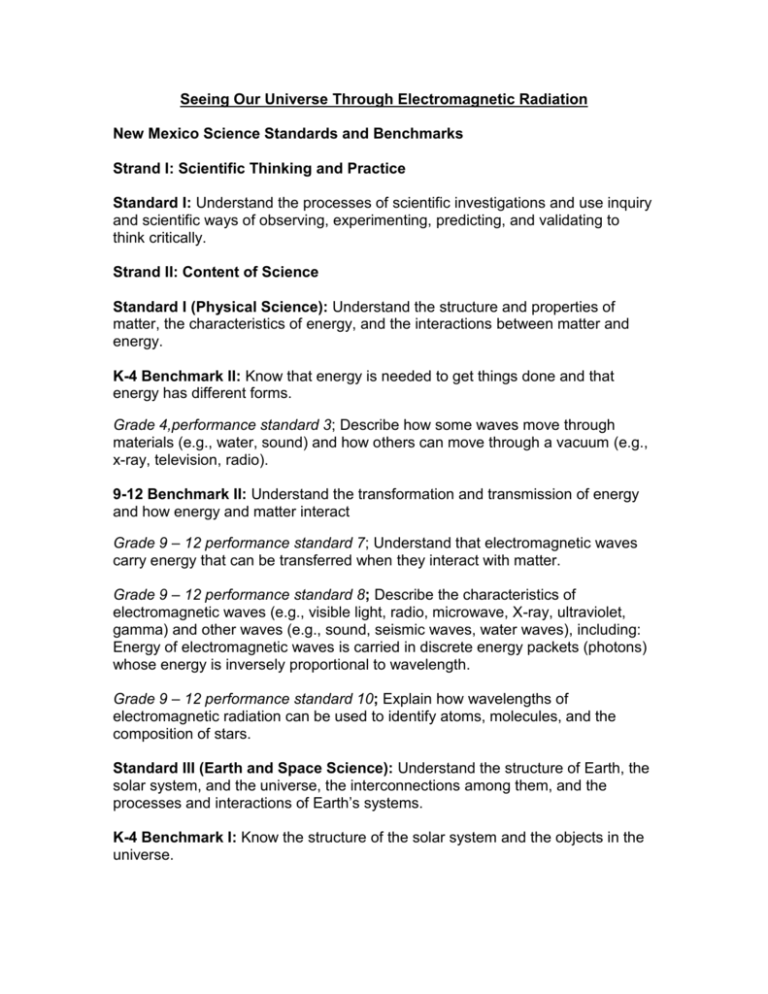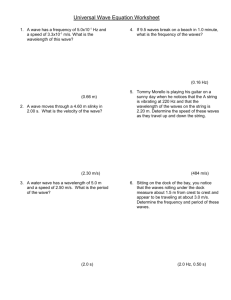Seeing Our Universe Through Electromagnetic Radiation
advertisement

Seeing Our Universe Through Electromagnetic Radiation New Mexico Science Standards and Benchmarks Strand I: Scientific Thinking and Practice Standard I: Understand the processes of scientific investigations and use inquiry and scientific ways of observing, experimenting, predicting, and validating to think critically. Strand II: Content of Science Standard I (Physical Science): Understand the structure and properties of matter, the characteristics of energy, and the interactions between matter and energy. K-4 Benchmark II: Know that energy is needed to get things done and that energy has different forms. Grade 4,performance standard 3; Describe how some waves move through materials (e.g., water, sound) and how others can move through a vacuum (e.g., x-ray, television, radio). 9-12 Benchmark II: Understand the transformation and transmission of energy and how energy and matter interact Grade 9 – 12 performance standard 7; Understand that electromagnetic waves carry energy that can be transferred when they interact with matter. Grade 9 – 12 performance standard 8; Describe the characteristics of electromagnetic waves (e.g., visible light, radio, microwave, X-ray, ultraviolet, gamma) and other waves (e.g., sound, seismic waves, water waves), including: Energy of electromagnetic waves is carried in discrete energy packets (photons) whose energy is inversely proportional to wavelength. Grade 9 – 12 performance standard 10; Explain how wavelengths of electromagnetic radiation can be used to identify atoms, molecules, and the composition of stars. Standard III (Earth and Space Science): Understand the structure of Earth, the solar system, and the universe, the interconnections among them, and the processes and interactions of Earth’s systems. K-4 Benchmark I: Know the structure of the solar system and the objects in the universe. Grade 4, performance standard 1; Understand that the number of stars visible through a telescope is much greater than the number visible to the naked eye. Grade 4, performance standard 2; Understand that there are various types of telescopes that use different forms of light to observe distant objects in the sky. 9-12 Benchmark I: Examine the scientific theories of the origin, structure, contents, and evolution of the solar system and the universe, and their interconnections. Grade 9 – 12 performance standard 3. Understand how knowledge about the universe comes from evidence collected from advanced technology (e.g., telescopes, satellites, images, computer models). Grade 9 – 12 performance standard 5. Explain how objects in the universe emit different electromagnetic radiation and how this information is used. Grade 9 – 12 performance standard 7. Examine the role that New Mexico research facilities play in current space exploration (e.g., Very Large Array, Goddard Space Center). Learning Objectives Students will demonstrate the properties of waves. Students will observe that waves bring energy and information. Students will compare and contrast images of our universe taken from different wavelengths and determine what information each image contains. Essential Question What are the processes that created our galaxy and solar system? Are there other planets orbiting stars that can sustain life as we know it? Vocabulary Wavelength, frequency, speed of light, light year, optical telescope, radio telescope, energy, photon, electromagnetic radiation, vacuum. Background Information View power point presentation 1st Activity To demonstrate the properties of waves, the different types of waves, and that waves travel at different speeds through different mediums, the students will become a wave. Materials 4 pieces of string 3 meters long, 4 pieces 1.5 meter long, 4 pieces 75 cm long, a stopwatch, data table. Set Up Five (or more) students will be the electromagnetic wave by standing in a line holding the string between them. The string should bend illustrating the trough of the wave; each student’s head is the crest. Another student stands in a set place, while the line walks by. This student will jump every time a “wave crest” passes. Another student will time how long it takes the line to pass the set point. While still another student records the data. Repeat this set up again using the different lengths of string to demonstrate different wavelengths, i.e. radio wave, infrared wave, ultra violet. To demonstrate that light waves travel at different speeds depending on what medium they travel through, i.e. water, glass. Have the student line walk at a different speed with the same length string. In small groups, using the data, calculate the frequency as cycles per second. The data should show an inverse relationship between wavelength (lengths of yarn) and the frequency. Assessment Students will draw a picture of the wave they were just apart of and label, crest, trough, and wavelength, and calculate frequency. 2nd Activity To observe that different information is obtained from radio telescopes and optical telescopes students will compare and contrast images taken of the same source in different wavelengths. Materials Sets of images taken at different wavelengths for each student group, and a Venn diagram worksheet. Set Up In small groups have students look at the pictures and fill in the Venn diagrams. Assessment Completed worksheet Other Activities Using observation and inference to discover that waves bring energy and information, fill a fairly large tub with water. Provide students with different sized objects to drop in the water to create waves. Then have the students close their eyes while you drop an object in the water, they should then open their eyes and observe the wave and describe the characteristics of the object that made the wave, and where the wave began. In the universe, acceleration electric charges make radio waves. You can detect these with a radio. Full lesson plan at http://www.gb.nrao.edu/epo/interf.html Illustrating the vocabulary words The American Association of Variable Star Observers has a nice hands-on activity showing the inverse relationship between the distances from the source of the electric field, as it increases, the strength of the field decreases. The lesson is attached. Wavelength Properties Data Sheet Wavelength (length of yarn) 2 meters 1 meter .5 meter Cycles (jumps) Time in seconds Frequency is calculated in Hertz (Hz), cycles per second. Divide the number of cycles by the amount of time it took. Wavelength 2 meters 1 meter .5 meter Frequency Notice how the wavelength decreases the frequency increases; this is called an inverse relationship. Draw a picture of the three different waves and label crest, trough, and wavelength.







